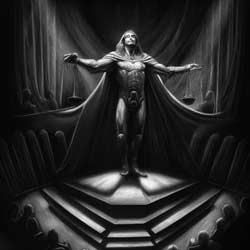 Venturing into the darker recesses of narrative character archetypes, this essay unveils the Anti-Hero, an entity immersed in complexity and contradiction. This figure, positioned between the heroic and the unheroic, ushers us into an exploration of the intricacies of human character, set against the backdrop of our shared narratives.
Venturing into the darker recesses of narrative character archetypes, this essay unveils the Anti-Hero, an entity immersed in complexity and contradiction. This figure, positioned between the heroic and the unheroic, ushers us into an exploration of the intricacies of human character, set against the backdrop of our shared narratives.
In the resplendent pantheon of character archetypes that adorn the vast corridors of our narratives, there exists a figure who, while cast in shadow, elicits an undeniable fascination - the 'Anti-Hero'. Shrouded in paradox and drenched in complexity, the Anti-Hero stands as a testament to the richness of human character, to the nuances that lie in the interstices of the heroic and the unheroic.
I. Understanding the Anti-Hero
The Anti-Hero is an archetype that defies the conventional parameters of heroism. Devoid of the traditional heroic qualities - valor, morality, altruism - the Anti-Hero is a flawed figure, marred by weaknesses and vices that make them relatable and, at times, uncomfortably familiar. They are the characters who, much like us, are caught in the tangles of their contradictions, teetering on the brink of virtue and vice.
Anti-Heroes are not necessarily villains; rather, they are complex characters who operate outside conventional morality. They may employ dubious means to achieve their ends, but these ends often align with a sense of justice, albeit a skewed one.
II. The Anti-Hero in the Narrative Structure
In the narrative structure, the Anti-Hero embarks on a journey akin to the traditional Hero's journey. However, this journey is imbued with a distinct darkness, a certain moral ambiguity that gives the narrative a different flavor.
The Anti-Hero's call to adventure may stem from selfish motives or a desire for revenge. Their refusal of the call may be dictated by cynicism or a sense of self-preservation. They may lack the mentor figure, relying instead on their cunning and resourcefulness. Their road of trials, ordeal, and reward reflect their internal struggle, their battle with their demons. The Anti-Hero's return to the ordinary world often involves a reckoning, a confrontation with the consequences of their actions.
III. Comparing and Contrasting the Anti-Hero and the Hero
When we place the Anti-Hero alongside the Hero, a fascinating comparison emerges. Both the Hero and the Anti-Hero embark on journeys of transformation. Both are capable of courage and resolve. Both can affect change in their world.
Yet, their motivations, their methods, and their moral compasses often diverge. While the Hero is motivated by altruism and a sense of duty, the Anti-Hero's motivations are often rooted in personal gain or revenge. The Hero's methods are marked by honor and virtue, while the Anti-Hero may resort to morally dubious or outright unethical means.
This contrast between the Hero and the Anti-Hero is not a black and white dichotomy but rather a spectrum. It reflects the complexity of human character, the gray area between good and evil, right and wrong. It underscores the diversity of our experiences, the range of our responses to adversity.
IV. Conclusion
In the end, the Anti-Hero stands as a testament to the intricacies of human nature, to the rich palette of character possibilities. They offer a counterpoint to the traditional Hero, a narrative tool that brings a unique flavor to the story. Their presence in our narratives challenges our preconceptions of heroism, nudging us to look beyond the black and white and embrace the shades of gray. The Anti-Hero, in their imperfect glory, reflects our shared humanity, our struggle with our contradictions, our journey through the interstices of virtue and vice.






